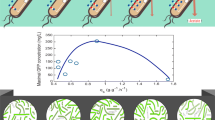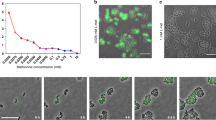Summary
A new approach to measuring the slowing of growth due to the manufacture of proteinsnot needed by a bacterium is presented. An entire single colony ofEscherichia coli was used to start a chemostat culture that was then given a selective pressure by the addition of phenylgalactoside (Φ-gal). This enriched the population for constitutive mutants that produced β-galactosidase without induction and could split Φ-gal, consume the galactose, and grow faster. When the Φ-gal was removed, the constitutives grew slower than the parental strain and were gradually lost. This procedure allows competition experiments to be carried out with minimum effects due to genetic drift. Experiments with both strains having wild-type and mutant permease genes were conducted. With the former the selective disadvantage was initially much greater than expected from the simplest hypothesis that extra unused proteins would slow growth in proportion to their fraction of the total protein synthesis.
This phase was followed by a second phase where the selective disadvantage was smaller than predicted by this simple hypothesis. With a very slowly reverting permease negative strain the selective disadvantage, and therefore the protein burden, was found to be much smaller and not statistically different from zero. Thus, while one would expect under carbon and energy limitation in the chemostat the protein burden to be larger than under unlimited conditions, it is so small that that even the refined technique used here could not measure it accurately. It is certainly less than the fraction of ‘waste’ protein synthesis; but it could be between zero and the fraction of the cells' energy and carbon budget spent on manufacture of the proteins of thelac operon.
Similar content being viewed by others
References
Andrews KJ, Hegeman GD (1976) Selective disadvantage of nonfunctional protein synthesis inEscherichia coli. J Mol Evol 8:317–328
Beckwith JR, Zipser D (1970) The Lactose Operon. Cold Spring Harbor, Laboratory, Cold Spring Harbor
Bochner BR, Savageau MA (1977) Generalized indicator plate for genetic metabolic and taxonomic studies with micro-organisms. Appl Environ Microbiol 33:434–444
Crandall M, Koch AL (1971) Temperature-sensitive mutants ofEscherichia coli affecting β-galactoside transport. J Bacteriol 105:609–619
Dykhuizen D (1978) Selection for tryptophan auxotrophy ofEscherichia coli in glucose-limited chemostats as a test of the energy conservation hypothesis. Evolution 32:125–150
Dykhuizen D, Hartl D (1978) Transport by the lactose permease ofEscherichia coli as the basis of lactose killing. J Bacteriol 135:876–882
Dykhuizen D, Davies M (1980) An Exerpimental Model: Bacterial specialists and generalists competing in chemostats. Ecology 6:1213–1227
Hegemann GD, Rosenberg SL (1970) The evolution of bacterial enzyme systems. Ann Rev Microbiol 24:429–462
Koch AL (1971) The adaptive responses ofEscherichia coli to a feast and famine existence. Adv Micro Physiol 6:147–217
Koch AL (1976) How bacteria face depression, recession, and derepression. Perspect Biol Med 20:44–63
Koch AL (1979) Microbial growth in low concentrations of nutrients. In: Shilo M (ed) Strategies of Microbial Life in Extreme Environments. Dahlem Konferenzen, Berlin, pp 261–279
Koch AL (1981) Evolution of antibiotic resistance gene function. Microbiol Rev 45:355–378
Koch AL, Levy HR (1956) Protein turnover in growing cultures ofEscherichia coli. J Biol Chem 217:947–957
Mason TG, Slater JH (1980) Competition between anEscherichia coli tyrosine auxotroph and a prototrophic revertant in glucose- and tyrosine-limited chemostats. Antonie van Leeuwenhoek 45:253–263
Miller JH (1972) Experiments in Molecular Genetics. Cold Spring Harbor Laboratory, Cold Spring Harbor
Miller, JH, Reznikoff WS (1978) The Operon. Cold Spring Harbor Laboratory, Cold Spring Harbor
Nath K, Koch AL (1970) Protein degradation inEscherichia coli: I. Measurement of rapidly and slowly decaying components. J Biol Chem 245:2889–2900
Norris TE, Koch AL (1972) Effect of growth rate on the relative rates of synthesis of messenger, ribosomal, and transfer RNA inEscherichia coli. J Mol Biol 64:633–649
Novick A, Weiner M (1957) Enzyme induction as an all-or-none phenomenon. Proc Natl Acad Sci USA 43:553–566
Smith TF, Sadler JR (1971) The nature of lactose operator constitutive mutations. J Mol Biol 59:273–305
Stouthamer AH (1979) The search for correlation between theoretical and experimental growth vields. In: Quayle JR (ed) Microbial Biochemistry, Vol 21, University Park Press, Baltimore, pp 1–47
Westerhof HV, Hellingwerf KJ, Van Dan K (1983) The dynamic efficiency of microbial growth is low but optimal for maximal growth rate. Proc Natl Acad Sci USA 80:305–309
Zamenhof S, Eichhorn HH (1967) Studies of microbial evolution through loss of biosynthetic functions: establishment of defective mutants. Nature 216:456–457
Zamenhof S, Zamenhof PJ (1971) Steady-state studies on some factors in microbial evolution. In: Perez-Miravette A and Palaeze D (eds) Recent Advances in Microbiology, Association Mexican Microbiology, pp 17–24
Author information
Authors and Affiliations
Rights and permissions
About this article
Cite this article
Koch, A.L. The protein burden oflac operon products. J Mol Evol 19, 455–462 (1983). https://doi.org/10.1007/BF02102321
Received:
Revised:
Issue Date:
DOI: https://doi.org/10.1007/BF02102321




